
Higher Estate & Gift Exemptions – $15M per individual ($30M per couple) permanently available – an ideal time to revisit ownership structures and succession planning.
The recently enacted One Big Beautiful Bill Act (OBBBA) introduces significant changes to dealership tax planning. Two provisions drive most 2025 modeling: accelerated cost recovery for capital investments and the return of the §163(j) business-interest limitation to 30% of EBITDA. Together, these changes expand expensing capacity for facilities, loaners, and equipment and influence financing structure. OBBBA also adjusts a range of other rules relevant to dealerships. Below are the key areas where OBBBA will impact dealership tax planning in 2025 and beyond.
Bonus Depreciation: Acquisition and In‑Service Both Required
OBBBA permanently restores 100% bonus depreciation for qualified property that is both (1) acquired after January 19, 2025, and (2) placed in service after that date. Property is not considered ‘acquired after’ January 19, 2025, if it is subject to a written binding contract entered into before that date. For dealerships, this is significant for facility build‑outs, major service equipment, and other long‑lead items where contracting often precedes installation. Treasury and IRS guidance is expected; until then, planning can reference prior binding‑contract frameworks to preliminarily assess acquisitions.
Typical eligible property includes service loaner fleets, tools and equipment, furniture and fixtures, land improvements, and non‑structural interior improvements. Federal and state treatment can differ; therefore, careful planning and modeling are essential.
Section 179: Alternative to Bonus Depreciation
In addition to bonus depreciation, recent enhancements to Section 179 expensing offer dealerships further opportunities for immediate cost recovery. Section 179 allows a taxpayer to elect to expense the cost of qualifying tangible personal property and certain qualified improvements in the year the property is placed in service, rather than recovering the cost through depreciation. The election is subject to annual dollar limits and a dollar-for-dollar phase-out as total qualifying additions exceed a threshold. OBBBA increases these limits to $2,500,000 and $4,000,000, effective for tax years beginning in 2025. Higher §179 capacity provides an alternative when a bonus is unavailable or suboptimal (for example, in a floorplan‑exception year). Unlike bonus depreciation, §179 can be elected on an asset‑by‑asset basis, allowing targeted expensing while managing overall taxable income among entities and owners.
Typical §179-eligible assets overlap with bonus depreciation: shop equipment and lifts, diagnostic tools, computers and point-of-sale systems, and furniture and fixtures; many vehicles may qualify, subject to limitations. In addition, §179 applies to non-structural interior improvements and also to specified building systems such as roofs, HVAC, and fire-protection/security systems.
When comparing §179 and bonus depreciation, conformity is state‑specific; some states allow §179 while limiting or disallowing bonus, and some modify or limit both. Given this variability, understanding both federal and state rules is crucial when determining the optimal expensing strategy.
§163(j) and Floorplan: EBITDA Standard Returns
Beyond expensing rules, OBBBA also brings important changes to interest deductibility and floorplan financing. Section 163(j) limits the deduction for business interest expense to 30% of adjusted taxable income (ATI). When enacted under the 2017 tax law, ATI resembled EBITDA; beginning in 2022, it shifted to an EBIT base by excluding depreciation and amortization, reducing interest expense for many capital-intensive businesses.
OBBBA restores ATI’s EBITDA formulation for tax years beginning after December 31, 2024. OBBBA also expands the floor-plan financing rules to include certain trailers and campers held in dealer inventory. For dealership groups, these changes may generally increase deductible non-floor-plan interest, free up interest expense carryovers, and expand the scope of the floor-plan exception.
The longstanding interaction remains: if the floor plan financing exception is used for a year in which §163(j) would otherwise limit interest, bonus depreciation is unavailable for that year.
Financing decisions and capital‑expenditure timing should be modeled together, given the return of the more favorable EBITDA standard, 100% bonus depreciation permanency, and increased Section 179 recovery.
Consumer Auto‑Loan Interest Deduction (2025–2028)
Turning to provisions that may affect customer decisions and dealership sales, from 2025 through 2028, individual taxpayers may deduct up to $10,000 per year of interest on loans for certain new vehicles with final assembly in the United States, subject to income‑based phase‑outs. Dealership teams should be prepared to verify U.S. final assembly and explain the basics to customers.
EV and Infrastructure Credits: Key Deadlines
In the energy incentives area, dealerships should be aware of accelerated phase-outs and key deadlines. OBBBA accelerates the sunset of several energy incentives. Electric-vehicle credits are significantly curtailed: the clean-vehicle credits—new, previously owned, and commercial—end for vehicles acquired after September 30, 2025, potentially pulling demand forward as the deadline approaches. In addition, the alternative fuel refueling property (charging) credit is no longer available for property placed in service after June 30, 2026; dealer-owned projects should be scheduled accordingly.
§461(l) Excess Business Loss: Permanent Constraint
OBBBA also makes permanent specific loss limitation rules under §461(l) that directly affect dealership owners of pass-through entities. The impact of this limitation for pass-through businesses is at the owner level; net business losses are only deductible up to the annual threshold; any excess is treated as a net operating loss carryover to subsequent years (subject to applicable NOL limitations). Dealer groups generating large deductions from bonus or §179 should model owner‑level results, as §461(l) can limit the current‑year benefit and affect estimated payments, distribution planning, and cash‑flow management. For tax year 2025, the threshold amount is $313,000 ($626,000 for married filing jointly), indexed annually for inflation.
Ownership Transition: Coordinate Timing and Tax
Finally, for dealer families considering succession or ownership transition, OBBBA introduces important changes to estate and gift tax exemptions. OBBBA increases and makes permanent the federal estate and lifetime gift exemption amount to $15 million per individual ($30 million for married couples), with future inflation adjustments. With higher federal estate‑tax exemptions in place, many dealer families are revisiting ownership and governance structures. Align entity and financing decisions (e.g., operating company vs. real‑estate lessor, compensation vs. distributions, basis planning) with transition objectives. Coordinating income‑tax modeling with the family’s estate counsel helps avoid cross‑purposes and supports efficient execution.
Why Modeling Matters Now
Under OBBBA, dealerships must navigate a unique set of interconnected tax changes. Acquisition cost recovery, interest expense limitations, owner-level loss restrictions, and state conformity all interact to determine your ultimate tax position. Given the interdependence of these provisions and evolving regulatory guidance, early and holistic modeling is more important than ever. Do not wait until year-end; model the impact of OBBA on your dealerships’ 2025 tax positions now.
Our Capabilities
Our team can help you anticipate challenges and maximize opportunities to ensure your dealership’s tax planning is fully aligned with the new landscape.


